
The Pirate Surgeon's Quarters: 1 2 3 4 5 6 7 8 9 10 11 12 <<First
The Pirate Surgeon's Quarters in the Golden Age of Piracy, Page 12
Battle Surgery: Bringing the Wounded to the Surgeon
"[1666, Second Dutch War] But we had not engaged above an hour but that an unlucky shot that come from the 'Holens' [Dutch ships], coming through our ship's side, hit me on the hollow of my ham on the right leg, it striking me
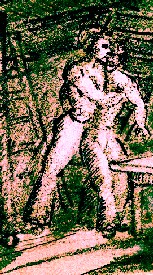
Bringing Down the Wounded
Unknown Artist, from
The
National Maritime Museums,
Greenwich, London (1820)
lame for the present, but I praise the Lord it was spent before it hit me or else it would have carried my leg away… but my leg swelling so that I could not go, I was forced to go down amongst the wounded men…" (Edward Barlow, p. 118-9)
When period accounts talk about taking the wounded to the surgeon, they, like Edward Barlow, usually refer to bringing them "down" to him, which makes sense given that he was usually on the orlop deck, one above the hold. However, this also meant that people were often needed to help those who were dazed, in pain and possibly even missing arms or legs from the decks above down the steep ladders onto the orlop.
Tobias Smollett gives an account of trying to obtain men for this purpose in his sarcastic account of the fictional life of surgeon Roderick Random. Random tells how the surgeon "bade me desire the boatswain to order some of the men to carry him down to the cockpit... When I signified to the boatswain the doctor's desire, he swore a terrible oath, that he could not spare one man from the deck, because he expected the mast would go
by the board every minute. This piece of information did not at all contribute to my peace of mind; however... with the
assistance of Morgan [another surgeon's mate], I supported him to the lower deck"1. Although Smollett's
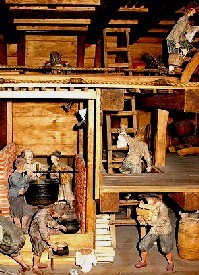
Photo: Peter Isotalo
The Ladders and Galley of the
Vasa
account is fictional, it was likely based at least in part in fact. One can readily imagine the importance a man trying to win a battle would place on having as many fighting men on deck as he possibly could.
Richard Wiseman seems to dismiss the issue of extra help as irrelevant, explaining that during his time serving as a surgeon at sea, he does not "remember I had ever any body to hold them [the patients]; but with the help of my [Surgeon's] Mates, and some one or two that belonged to the Hold, I went on with my work. At Sterling I made an Amputation on above the knee and had as little help; besides my Servants, there was only a Sea-Chirurgion assisting me."2 Of course, he doesn't explain who was delivering the wounded here.
Being of those involved in helping the men below would necessarily involve repeated trips up and down the steep ladders while assisting or even carrying the wounded man. There was a great deal of potential hazard in assisting the wounded to the orlop deck. While giving an account of his role as helper to the wounded during a battle on a French privateer, Père Jean-Baptiste Labat tells us "when I was going down to the cockpit (fosse aux lions) to help with a wounded man who was being carried to the surgeon, the ladder on which I was standing was cut through under my feet by a cannon ball and the galley which was hit at the same moment covered me with debris."3
Once the wounded were delivered to the orlop, something had to be done with them. James Yonge was a surgeon's assistant Battle with the Turks in Algiers in 1659. During that engagement, he reported that he "went down presently to my quarters,
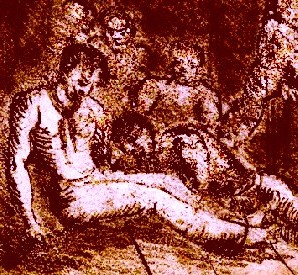
The Wounded in the Cockpit,
Unknown Artist, from
The
National Maritime Museums,
Greenwich, London (1820)
which was a platform in the after part of the hold laid over with beds to put the wounded men on, and under the scuttle they were to come down at lay a heap of cloths for their soft and easy descent, to be dressed."4 Presumably the prisoner was moved away from heap of clothes once he reached the orlop deck or they wouldn't have served their purpose very well.
Indeed, if the battle were particularly bloody, space became a problem. In 1805, Simon Gage Britton - the surgeon aboard the naval schooner Pickle - was brought aboard the Victory to help the surgeon there because "rows of shattered men lying on the orlop deck were so overwhelming."5
Robert Young aboard the Ardent in 1797 detailed in his report that "[n]inety wounded were brought down during the action, the whole cockpit cabin, wing berths, and part of the cable tier together with my platform and my preparations for dressing were covered with them so that for a time they were laid on each other at the foot of the ladder where they were brought down"6. Young responded to this crises by explaining the problem to the ship's commanding officer and requesting men to come down and move the wounded away from the ladder and cockpit so that he could work. This brings us right back to the first problem noted in this section - taking men needed for the fight away from the battle.
1 Tobias Smollett, The Adventures of Roderick Random, p. 184-5; 2 Richard Wiseman, Of Wounds, Severall Chirurgicall Treatises, p. 452; 3 Pere Jean-Baptiste Labat, The Memoirs of Pére Labat 1693-1705, p. 29; 4 James Yonge, The Journal of James Yonge [1647-1721] Plymouth Surgeon, p. 41-2; 5 Kevin Brown, Poxed and Scurvied: The Story of Sickness and Health at Sea, p. 90; 6 Robert Young's Journal cited in Jonathan Charles Goddard, "An insight into the life of Royal Naval surgeons during the Napoleonic War, Part 1," Journal of the Royal Naval Medical Service, Winter 1991, p. 211-2
Battle Surgery: Treatment Order and the Effect on the Operating Theater
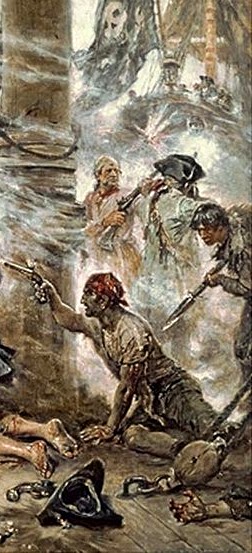
Artist: Gene Leon Gerome Ferris
Pirate Battle, taken from The Capture of
Blackbeard the Pirate (1920)
Battle damage varied, although the types of wounds would have been fairly consistent - they would have been things like cuts, bruises, smashed and pinched digits, bullet wounds, splinters, concussions and burns. How they would be treated depended on the wounds, the ease of treatment and their severity. John Atkins advises his reader to consider, "that Compound Fractures and Amputations will take up necessarily near the Whole of his Time." He draws the surgeon's attention to the simplicity of flesh wounds, "by Great Guns or Splinters" explaining that they "are commonly large enough to discover any extraneous Body [in them, which is] to be extracted presently with your Fingers or Forceps"1.
James Yonge's account of the battle with the Turks in Algiers which lasted six hours highlights the sorts of battle wounds that were encountered.
We had only the boatswain and one man more slain. Men wounded were the Leiftenant, wounded deeply on the buttocks with a splinter; a reformado gent [volunteer serving in the military without a commission but with an officer's rank] named Wm. Gregory had the upper part of his foot torn with a splinter; one Patrick, an Isle of Wight man, had both buttocks much lacerated by a shot; a boy had the calf of his leg torn by a splinter, and a Scotsman had the pan of the knee torn by a bullet, which Mr. Robinson [the surgeon under which Yonge served] dressing up without amputation till the next day cost the poor man of his life. All the rest recovered; some few more were scalded, bruised, and had slight hurts not worth minding.2
Note the dismissive way Yonge addresses burns and bruises - this suggests that these sorts of wounds would have been accorded a lower priority than the others. This may have been because of the seriousness of the other wounds which requiring more immediate attention. It could also be due, in part, to the way the wounds were received. William Funnell noted that in a conflict with a Spanish Man of war, "two [men] thro' carelessness had their Hands and Faces blasted; but in a small time they both recovered."3
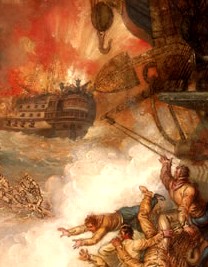
Artist: Mather Brown
Ship Alight, The Battle of the Nile(1825)
While this may have been the case with smaller burns caused by spilled gunpowder or sparks from firing weapons, but fire could also be used by the enemy as a weapon. On his privateering voyage in the Caribbean and South America, Woodes Rogers reported that "the Enemy threw a Fire-ball out of one of her Tops, which lighting upon our Quarter-deck, blew up a Chest of Arms and Cartouch Boxes all loaded, and several Cartridges of Powder in the Steerage, by which mean Mr. Vanbrugh, our Agent, and a Dutchman were very much burnt; it might have done more Damage, had it not been quench'd as soon as possible."4
When trying to determine what to treat, Atkins advises the surgeon "to be quick, as well as careful, in what Help you administer; for if the Action be warm, without Forethought, you will be in Confusion presently". He suggests not allowing "such wounded Men as can walk, and help themselves" to take up space on the orlop deck, particularly near the cockpit, "but move [them] on to the Hold or Foreship"5.
1 John Atkins, The Navy Surgeon, p. 148; 2 James Yonge, The Journal of James Yonge [1647-1721] Plymouth Surgeon, p. 41-2; 3 Funnell, William, A Voyage Round the World, p. 56; 4 Woodes Rogers, A Cruising Voyage Round the World, p. 161; 5 Atkins, ibid.
Battle Surgery: Operating Theater Conditions During a Fight
"The surgeon and his mate were smeared with blood from head to foot: they looked more like butchers than doctors." (Samuel Leech, Thirty Years From Home, p. 142)
We have already looked at the general conditions on the orlop deck, but during battle there would be additional challenges created by the conflict and the greater volume of the wounded men to be treated. Note that all of the descriptions of the orlop deck during battle found here are from after the golden age of piracy. Since it is doubtful that things would have been significantly better before these accounts, we will use them as proxies for
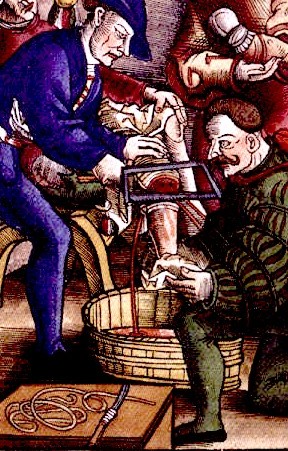
Amputating into a Bucket of Blood, taken from der
Wundartzney
by Hans Von Gersdorff (~1540)
what it must have been like during the time period of interest. Many of the more dramatic accounts make the surgeon's domain during battle sound like one of Dante's circles of hell.
Leech's account of the surgery would surely have resonated with a pirate surgeon during a particularly long and grisly battle. "It was with exceeding difficulty I moved through the steerage, it was so covered with mangled men, and so slippery with streams of blood."1 Recalling that Moyle suggested having empty buckets to collect the blood and the tendency for arteries to shoot blood prodigiously when severed, one can readily appreciate how this might be true.
Robert Young of the Ardent in the Battle of Campersdown explained how only after the battle was over, was it "possible to get a platform cleared and come at the materials for operating and dressing, those I had prepared [prior to the action] being covered over with blood and the store room door [being] blocked up [by bodies]."2
Some times the damage was not as catastrophic and the surgeon's work would have been lighter. James Yonge's account of the battle with the Turks in Algiers in the previous section highlights such an battle. At other times, there was a great deal of damage and the surgeon was in for a tough slog. Robert Young reported that during the Battle of Campersdown, "I was employed in operating and dressing till near four in the morning, the action beginning about one in the afternoon. So great was my fatigue that I began several amputations under dread of sinking before I should have secured the blood vessels. Ninety wounded were brought down during the action"3.
The orlop deck could be very hot, especially when the ship was in a warm climate like the Caribbean. If the warfare was particularly brisk, the deck could be crowded with men confined together and even lying on top of each other as we have seen. Since there were no ports to the outside the air would be further warmed by the sheer number of bodies there. The deck above the orlop was usually a cannon deck, with multiple cannons spitting their fire as quickly as the gun crews could load them, emitting still more heat.
A report by a surgeon in 1816 suggests just how miserable the conditions could be.
The intense heat those unfortunate men were unavoidably exposed to in the cockpit for many hours and which, together with my exertions there for more than sixteen hours, produced an universal eruption over my body, and an extensive swelling of my inferior extremities. The thermometer, after the explosion, and consequent presence of seventy burnt men and boys, stood as high as from 136 to 140; and had I been of a weaker habit, I must inevitably have sunk under so long an exposure to such a degree of temperature. How much more, then, must the wounded have suffered!4
Artist: Gene Ferris
Taken from The Capture
of
Blackbeard the Pirate
Another facet of the closed, crowded space being located below the gun deck would have been the noise. Multiple cannons on the deck above would be alternatively firing repeatedly every few minutes.
In addition, the surgeon had also to deal with a more pitiful noise; that of the wounded men calling for his attention. In Leech's account, he explains how he "passed through the steerage, which was strewed with the wounded: it was a sad spectacle, made more appalling by the groans and cries which rent the air. Some were groaning, others were swearing most bitterly, a few were praying, while those last arrived were begging most piteously to have their wounds dressed next."5
In 1755, surgeon Edward Ives reported that as he was amputating, he had "an almost continual interruption from the rest of [the patient's] companions who were in the like distressful circumstances; some pouring forth the most piercing cries to be taken care of, while others seized my arm in their earnestness of being relieved, even at the time that I was passing the needle for securing the divided blood vessels by a ligature."6
Wounded Men, taken from Famous Privateersmen
and Adventurers of the Sea,
by Charles H. L.
Johnston
(1911)
Robert Young's account again gives us a most vivid insight into the cries of the wounded.
Melancholy cries for assistance were addressed to me from every side by wounded and dying and piteous groans and bewailings from pain and despair. In the midst of these agonizing scenes I was enabled to preserve myself firm and collected, and embracing in my mind the whole situation to direct my attentions where the greatest and most essential services could be performed. Some with wounds bad indeed and painful but slight in comparison with the dreadful condition of other were most vociferous for my assistance, these I was obliged to reprimand with severity as their noise disturbed the last moments of the dying. I cheered and commended the patient fortitude of others and sometimes exhorted a smile of satisfaction from the mangled sufferers and succeeded to thrown momentary gleams of cheerfulness amidst so many horrors...7
1 Samuel Leech, Thirty Years From Home, p. 142; 2 Robert Young's Journal cited in Jonathan Charles Goddard, "An insight into the life of Royal Naval surgeons during the Napoleonic War, Part 1," Journal of the Royal Naval Medical Service, Winter 1991, p. 211; 3 Robert Young’s Journal, cited in Sir Cecil Wakely, Surgeons and the Navy, transcript of Thomas Vicary Lecture delivered at the Royal College of Surgeons in England on 11/14/1957; 4 Cited in Wakely, p. 284; 5 Leech, p. 141-2; 4 Cited in Wakely, p. 284; 7 Young’s Journal, cited in Goddard, p. 211
Battle Surgery: Post Battle
After the battle was finished there was still much work to be done on

Artist: William H Pyne
(1808)
the orlop deck. The decks would have to be scrubbed to remove all the blood spilled. The amputated limbs would now have to be 'heaved overboard.'1 The bodies of those who didn't survive could also be disposed. In his account from the Battle of Campersdown, Robert Young explained that "[a]fter the action ceased fifteen or sixteen dead bodies were removed."2 The wounded men could also be moved either to their bunks or to a sick bay if the ship had established one. One suspects that pirates would be more likely to be moved to their bunks, although no proof exists against a pirate surgeon having established a sick bay.
Just because the battle was over, didn't mean that the surgical duties were. James Yonge opines "Here began my slavery, for boiling gruel, barley water fomentations, washing rollers, and making lint, spreading plaisters and fitting the dresses [dressings?], was wholly on my hands, besides often emptying the buckets they went to stool in, a nasty and mean employment, but such as usually chyrurgeon's mates formerly did in the navy."3 Clearly the surgeon would delegate the menial tasks to his mates and assistants when he had the luxury to do so.
However, this didn't mean the surgeon was free from responsibility. Moyle gives a rather extensive account of
the activities of the surgeon in the first two days following a battle.

Artist: Adriaen Brouwer
Bleeding, taken from Feeling (1635)
According to him,
...the first day after the Fight you are to dress only the slighter Wounds, the sooner to bring them to digestion [suppuration - the formation of pus - to force the bad humors out]; and such as are burnt with Powder (for those may not be omitted) and Contusions must be embrocated. ...such as have penetrating Wounds, and inward Bruises, must have this day (as well as at first) the Traumaticks administred...
And any that have not bled sufficiently after their Contusions are to have Phlebotomy [bloodletting] celebrated.
And this day you must provide Cradles for the wounded; you must speak to the Commander and he will order them to be made.4
An interesting point in that list was the commencement of bloodletting. Like suppuration, bloodletting was believed to allow the ill humors in the body to be released so that healing could proceed. Bloodletting was not typically used on the day a wound was received because it was thought that the natural bleeding of a new wound had already released the bad humors at that point. There was also concern that the present blood loss had also weakened the patient making more bloodletting inadvisable.
Moyle also details the second day of treatment.
You must now, not only repeat what has been said already [in the first day's procedure], but you must likewise dress all Wounds, whether incised, Punctured, Contused, or Gunshot; where a Violent Hemorage is not expected...
You must now also observe which of the wounded is Costive or inclining to be Feverish: and let such have emollient Clysters [enemas] injected...5
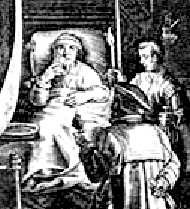
Artist: Theodor Galle (1570)
The fever Moyle mentions was likely caused by the onset of infection which the clysters likely did little to help.
Casualties might also be sent ashore following a battle if that were possible. Edward Barlow reports that in 1666, following a battle in the second Dutch War where he was wounded that he was put ashore. He explains that of the wounded men, "we were sent some to one house and some to another. His Majesty paying seven shillings a week for every man for his 'diate' and looking after, there being a kind of an hospital where they lay that were worst wounded, and a doctor to dress them, which we went to every day from the other places when we wanted any dressing."6
Being wanted men, pirates could not be put ashore with their care paid for by his majesty. Nor could they enjoy the amenities of a public hospital, for they were criminals who would be hung if caught. However, pirates wounded in battle were sometimes paid for their troubles according to their articles and might even make it ashore to recuperate.
1 John Moyle, The Sea Chirurgeon, p. 49; 2 Robert Young's Journal cited in Jonathan Charles Goddard, "An insight into the life of Royal Naval surgeons during the Napoleonic War, Part 1," Journal of the Royal Naval Medical Service, Winter 1991, p. 211; 3 James Yonge, The Journal of James Yonge [1647-1721] Plymouth Surgeon, p. 42; 4 Moyle, p. 56-7; 5 Moyle, p. 57; 6 Edward Barlow, Barlow’s Journal of his Life at Sea in King’s Ships, East and West Indiamen & Other Merchantman From 1659 to 1703, p. 122

